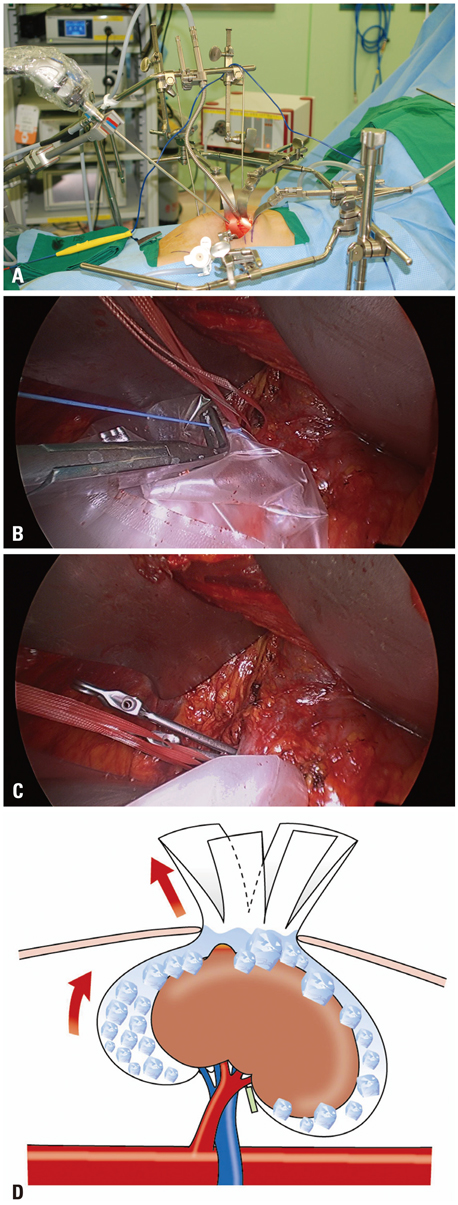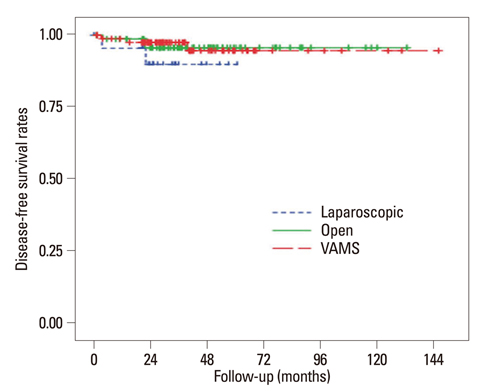Yonsei Med J.
2012 Jan;53(1):151-157. 10.3349/ymj.2012.53.1.151.
Comparison of Video-Assisted Minilaparotomy, Open, and Laparoscopic Partial Nephrectomy for Renal Masses
- Affiliations
-
- 1Department of Urology, CHA Bundang Medical Center, CHA University, Seongnam, Korea.
- 2Department of Urology, Urological Science Institute, Yonsei University College of Medicine, Seoul, Korea. hanwk@yuhs.ac
- KMID: 1779700
- DOI: http://doi.org/10.3349/ymj.2012.53.1.151
Abstract
- PURPOSE
Minimally invasive management of small renal tumors has become more common. We compared the results of partial nephrectomy by video-assisted minilaparotomy surgery (VAMS), open, and laparoscopic techniques.
MATERIALS AND METHODS
We retrospectively compared clinicopathological, oncological, and functional outcomes in 271 patients who underwent partial nephrectomy for renal tumors at one institution from 1993 to 2007; including 138 by VAMS, 102 by open, and 31 by laparoscopic technique.
RESULTS
Mean follow-up was 47.7+/-29.1 months. No statistically significant differences in the three groups were found in tumor size, tumor location, estimated blood loss, complication rate, preoperative glomerular filtration rate (GFR), and GFR at last follow-up. Ischemic time was shorter in the open (26.9 min) and VAMS (29.3 min) groups than in the laparoscopic group (31.0 min, p=0.021). Time to normal diet and hospital stay were shorter in the VAMS (1.8 days and 5.4 days) and laparoscopic (1.8 days and 4.7 days) groups than in the open group (2.4 days and 7.3 days, p=0.036 and p<0.001, respectively). Of 180 patients with cancer, positive surgical margins occurred in 2 of 82 patients (2.4%) in the VAMS group, none of 75 patients in the open group, and 3 of 23 patients (13.0%) in the laparoscopic group (p=0.084). In the VAMS, open, and laparoscopic groups, 5-year disease-free survival was 94.8%, 95.8%, and 90.3% (p=0.485), and 5-year cancer-specific survival was 96.3%, 98.6%, and 100%, respectively (p=0.452).
CONCLUSION
Partial nephrectomy using VAMS technique provides surgical, oncologic, and functional outcomes similar to open and laparoscopic techniques.
MeSH Terms
-
Adult
Aged
Carcinoma, Renal Cell/mortality/*surgery
Female
Humans
Kidney Neoplasms/mortality/*surgery
Laparoscopy/instrumentation/*methods
Laparotomy/instrumentation/*methods
Male
Middle Aged
Nephrectomy/instrumentation/*methods
Retrospective Studies
Treatment Outcome
Video-Assisted Surgery/instrumentation/*methods
Figure
Reference
-
1. Yang SC, Ko WJ, Byun YJ, Rha KH. Retroperitoneoscopy assisted live donor nephrectomy: the Yonsei experience. J Urol. 2001. 165:1099–1102.
Article2. Yang SC, Rha KH, Byun YJ, Kim WY. Video-assisted minilaparotomy in urology. J Endourol. 2003. 17:465–467.
Article3. Han WK, Lee HY, Jeon HG, Joo DJ, Rha KH, Yang SC. Quality of life comparison between open and retroperitoneal video-assisted minilaparotomy surgery for kidney donors. Transplant Proc. 2010. 42:1479–1483.
Article4. Levey AS, Bosch JP, Lewis JB, Greene T, Rogers N, Roth D. A more accurate method to estimate glomerular filtration rate from serum creatinine: a new prediction equation. Modification of Diet in Renal Disease Study Group. Ann Intern Med. 1999. 130:461–470.
Article5. Clavien PA, Barkun J, de Oliveira ML, Vauthey JN, Dindo D, Schulick RD, et al. The Clavien-Dindo classification of surgical complications: five-year experience. Ann Surg. 2009. 250:187–196.6. Jeong W, Park SY, Lorenzo EI, Oh CK, Han WK, Rha KH. Laparoscopic partial nephrectomy versus robot-assisted laparoscopic partial nephrectomy. J Endourol. 2009. 23:1457–1460.
Article7. Gill IS, Desai MM, Kaouk JH, Meraney AM, Murphy DP, Sung GT, et al. Laparoscopic partial nephrectomy for renal tumor: duplicating open surgical techniques. J Urol. 2002. 167:469–476.
Article8. Adkins KL, Chang SS, Cookson MS, Smith JA Jr. Partial nephrectomy safely preserves renal function in patients with a solitary kidney. J Urol. 2003. 169:79–81.
Article9. Suzuki K, Masuda H, Ushiyama T, Hata M, Fujita K, Kawabe K. Gasless laparoscopy-assisted nephrectomy without tissue morcellation for renal carcinoma. J Urol. 1995. 154:1685–1687.
Article10. Suzuki K, Ishikawa A, Ushiyama T, Fujita K. Retroperitoneoscopic living donor nephrectomy without gas insufflation: the five-year Hamamatsu University experience. Transplant Proc. 2002. 34:720–721.
Article11. Fergany AF, Saad IR, Woo L, Novick AC. Open partial nephrectomy for tumor in a solitary kidney: experience with 400 cases. J Urol. 2006. 175:1630–1633.
Article12. Gill IS, Colombo JR Jr, Moinzadeh A, Finelli A, Ukimura O, Tucker K, et al. Laparoscopic partial nephrectomy in solitary kidney. J Urol. 2006. 175:454–458.
Article13. Marszalek M, Meixl H, Polajnar M, Rauchenwald M, Jeschke K, Madersbacher S. Laparoscopic and open partial nephrectomy: a matched-pair comparison of 200 patients. Eur Urol. 2009. 55:1171–1178.
Article14. Gill IS, Kavoussi LR, Lane BR, Blute ML, Babineau D, Colombo JR Jr, et al. Comparison of 1,800 laparoscopic and open partial nephrectomies for single renal tumors. J Urol. 2007. 178:41–46.
Article15. Kwon EO, Carver BS, Snyder ME, Russo P. Impact of positive surgical margins in patients undergoing partial nephrectomy for renal cortical tumours. BJU Int. 2007. 99:286–289.
Article16. Porpiglia F, Fiori C, Terrone C, Bollito E, Fontana D, Scarpa RM. Assessment of surgical margins in renal cell carcinoma after nephron sparing: a comparative study: laparoscopy vs open surgery. J Urol. 2005. 173:1098–1101.
Article17. Thompson RH, Leibovich BC, Lohse CM, Zincke H, Blute ML. Complications of contemporary open nephron sparing surgery: a single institution experience. J Urol. 2005. 174:855–858.
Article
- Full Text Links
- Actions
-
Cited
- CITED
-
- Close
- Share
- Similar articles
-
- Clinical Experience of Video-Assisted Minilaparotomy Radical Nephrectomy for Renal Cell Carcinoma
- A Comparison of Open, Laparoscopic, and Video-Assisted Minilaparotomy Radical Nephrectomy
- Cost Aspects of Radical Nephrectomy for the Treatment of Renal Cell Carcinoma in Korea: Open, Laparoscopic, Robot-Assisted Laparoscopic, and Video-Assisted Minilaparotomy Surgeries
- Video Assisted Minilaparotomy Surgery (VAMS) - Live Donor Nephrectomy: 239 Cases
- Video-Assisted Minilaparotomy Surgery (VAMS): Challenging Cases of Nephron-Sparing Surgery in a Solitary Kidney



